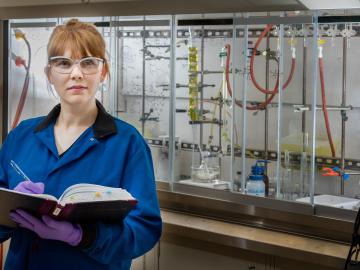
Filter News
Area of Research
- Advanced Manufacturing (7)
- Biological Systems (1)
- Biology and Environment (4)
- Building Technologies (1)
- Clean Energy (61)
- Climate and Environmental Systems (2)
- Computational Engineering (1)
- Computer Science (8)
- Fusion and Fission (1)
- Fusion Energy (6)
- Isotopes (1)
- Materials (57)
- National Security (7)
- Neutron Science (24)
- Nuclear Science and Technology (11)
- Quantum information Science (3)
- Supercomputing (31)
- Transportation Systems (1)
Date
News Topics
- 3-D Printing/Advanced Manufacturing (27)
- Advanced Reactors (10)
- Artificial Intelligence (34)
- Big Data (15)
- Bioenergy (19)
- Biology (11)
- Biomedical (10)
- Biotechnology (6)
- Buildings (13)
- Chemical Sciences (12)
- Clean Water (8)
- Climate Change (19)
- Composites (6)
- Computer Science (53)
- Critical Materials (4)
- Cybersecurity (5)
- Decarbonization (20)
- Education (1)
- Emergency (1)
- Energy Storage (16)
- Environment (37)
- Exascale Computing (7)
- Fossil Energy (2)
- Frontier (8)
- Fusion (10)
- Grid (11)
- High-Performance Computing (13)
- Isotopes (12)
- ITER (1)
- Machine Learning (13)
- Materials (14)
- Materials Science (34)
- Mathematics (2)
- Mercury (1)
- Microelectronics (1)
- Microscopy (7)
- Molten Salt (1)
- Nanotechnology (8)
- National Security (14)
- Net Zero (5)
- Neutron Science (28)
- Nuclear Energy (26)
- Partnerships (12)
- Physics (10)
- Polymers (7)
- Quantum Computing (10)
- Quantum Science (22)
- Security (4)
- Simulation (12)
- Space Exploration (7)
- Statistics (2)
- Summit (13)
- Sustainable Energy (24)
- Transportation (24)
Media Contacts

Sometimes solutions to the biggest problems can be found in the smallest details. The work of biochemist Alex Johs at Oak Ridge National Laboratory bears this out, as he focuses on understanding protein structures and molecular interactions to resolve complex global problems like the spread of mercury pollution in waterways and the food supply.

An online tool developed by researchers at Oak Ridge National Laboratory provides architects and engineers a fast and efficient way to assess the performance of a building’s envelope design before construction begins.

Researchers have pioneered a new technique using pressure to manipulate magnetism in thin film materials used to enhance performance in electronic devices.

Oak Ridge National Laboratory physicists studying quantum sensing, which could impact a wide range of potential applications from airport security scanning to gravitational wave measurements, have outlined in ACS Photonics the dramatic advances in the field.

In the shifting landscape of global manufacturing, American ingenuity is once again giving U.S companies an edge with radical productivity improvements as a result of advanced materials and robotic systems developed at the Department of Energy’s Manufacturing Demonstration Facility (MDF) at Oak Ridge National Laboratory.
The Department of Energy’s Oak Ridge National Laboratory has named Marcel Demarteau as Physics Division Director, effective June 17.

Oak Ridge National Laboratory welcomed seven technology innovators to join the third cohort of Innovation Crossroads, the Southeast’s only entrepreneurial research and development program based at a U.S. Department of Energy national laboratory.

An organic chemist at Oak Ridge National Laboratory, Santa Jansone-Popova focuses on the fundamental challenges of chemical separations that translate to world-changing solutions for clean water and sustainable energy.

The Department of Energy has established the Innovation Network for Fusion Energy program, or INFUSE, to encourage private-public research partnerships for overcoming challenges in fusion energy development.

For the first time, Oak Ridge National Laboratory has completed testing of nuclear fuels using MiniFuel, an irradiation vehicle that allows for rapid experimentation.


